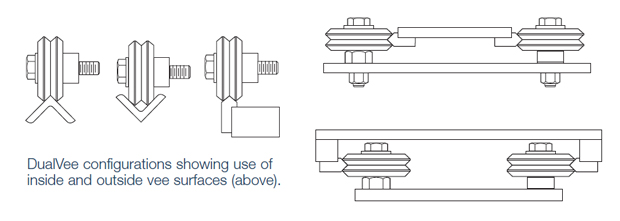Thursday, October 4, 2012
Explore the Guided Motion Possibilities of Linear Bearings with Applications Engineer Dan Fletcher, Coffee Chat Part II of III
[ This is Part II of a three-part series on guided motion basics — read Part I here ]
TOLERANCES AND LUBRICATION We're picking up from yesterday's conversation about the form, function and range of environments that DualVee Motion Technology® is built to handle. Today, we'd like to talk about the tolerances and lubrication of the double row angular contact bearing. We continue the series with one of our Applications Engineers, Dan Fletcher.
Tell us about DualVee's tolerances — what are the contact bearing's basic capabilities?
Dan: Most of the time, an off-the-shelf guide wheel system should meet positioning tolerances of +/-0.005 inches, depending on the surface. If the track is hardened and ground to specific tolerances, the bearing could then meet positioning tolerances of +/-0.001 inches.
More often than not, double row angular contact bearing designs rely on the track's base mounting surface to maintain accuracies and tolerances. If the mounting is stiffer than the track, the track will adapt to the flatness, straightness, parallelism and twist — if designed with that in mind. If the design doesn't need to be that precise, the mounting surfaces don't have to be as demanding, which lessens the overall cost of the project.
Can you elaborate?
Dan: Well, for example, if the application needs tolerances of +/-0.004 inches, you can bolt a guide wheel system to a sort-of uneven surface and a carriage will still work and run smoothly. Time spent on preparing the surface is minimal, though, and so is the cost and time spent to install it. But if you need +/-0.001 inches for an application, that just means spending more time to prepare the mounting surface, which raises the price.
Why is lubrication important?
Dan: As with many bearing systems, proper lubrication will enhance service and product life.
What if lubrication isn't a requirement for an application?
Dan: If that's the case, the guide wheels are still often a preference over alternative motion technologies. Lots of cleanroom applications in the medical industry demand dry rollers to cut out possibility of contamination, to cite one example.
[ Join us next week for the final installment in this series, where we talk about DualVee Sizing Tips ]


